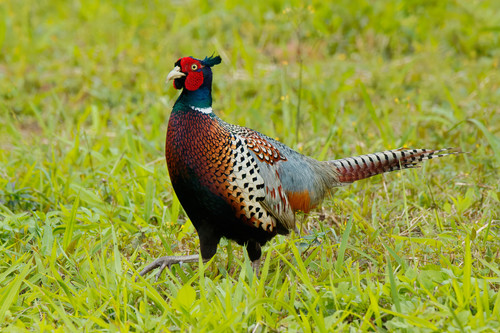
Ring-necked Pheasant
The Ring-necked Pheasant (Phasianus colchicus) is a widespread bird species, renowned for its vibrant plumage and significant presence in both natural and agricultural landscapes. Originally native to Asia, it has been widely introduced across the globe, becoming a familiar sight in many regions. This species plays a crucial role as both a game bird and a seed disperser, influencing local ecosystems. Culturally, it is often associated with rural life and hunting traditions.
50-90 cm
Length
70-90 cm
Wingspan
Least Concern
Conservation Status
Distribution
Native to Asia, ranging from the Black Sea to China and Korea. Widely introduced and established in North America, Europe, Australia, and New Zealand. Migratory in some northern parts of its native range.
Lifespan
Typically 1-3 years in the wild, up to 18 years in captivity.
Ring-necked Pheasant's Habitat
Habitat Types
Grasslands, Agricultural fields, Woodland edges, Wetlands
Climate Zones
Temperate, Subtropical
Adaptations
Ring-necked Pheasants have strong legs and feet adapted for running and scratching the ground to find food. They are well-suited to open habitats with dense ground cover for nesting and protection.
Variations
Numerous subspecies exist, differing in plumage coloration and size. Some island populations show distinct characteristics due to geographic isolation.
Appearance
Breeding Plumage
Males have bright, colorful plumage during breeding season, with a distinctive white neck ring. Non-breeding males and females have more subdued, cryptic coloration.
Seasonal Feather Changes
Plumage is brightest during the breeding season, becoming duller after molting.
Sex Based Plumage Differences
Significant dimorphism; males are brightly colored with long tails, while females are mottled brown for camouflage.
Notable Features
White neck ring (in males), Long, pointed tail feathers (especially in males), Bright copper and gold body plumage (in males)
Diet and Feeding
Primary Foods
Seeds, Grains, Insects, Berries, Leaves
Foraging Behavior
Forages on the ground by scratching with feet and pecking. Often feeds in open fields and along edges of vegetation.
Specializations
Strong legs and feet for scratching; robust bill for cracking seeds.
Seasonal Diet Variations
Diet shifts seasonally; more insects are consumed in spring and summer, while seeds and grains are dominant in fall and winter.
Behavior
Social Structure
Generally solitary or in small groups, except during breeding season when males establish territories and gather harems of females.
Communication
Loud crowing calls by males, Clucking and other soft vocalizations, Visual displays during courtship
Migration
Mostly non-migratory, but some populations in colder regions may move short distances to find food in winter.
Territorial or Group Behaviors
Males are highly territorial during the breeding season, defending their territories against rivals. Females and young often form small flocks.
Conservation
Threats
Habitat loss due to agriculture and urbanization, Pesticide use, Predation by introduced species, Hunting pressure in some areas
Protection Programs
Habitat restoration projects, Hunting regulations and management programs
Local National Laws
Protected under various wildlife laws in many countries; hunting is often regulated.
Population Trend
Stable
Population Estimates
Global population estimated to be in the millions, with wide variations across different regions.
Interesting Facts
Ring-necked Pheasants are not native to North America.
They were introduced from Asia in the late 19th century and have since become a popular game bird.
They can fly at speeds up to 60 mph.
But typically only for short bursts to escape predators.
The male's long tail feathers can make up more than half of its total body length.
These feathers play a role in courtship displays.
A group of pheasants is called a 'nye' or 'bouquet'.
Faqs about Ring-necked Pheasant
What is the average lifespan of a Ring-necked Pheasant?
In the wild, they typically live 1-3 years, but they can live up to 18 years in captivity.
Are Ring-necked Pheasants good fliers?
They are capable of strong, short bursts of flight, mainly to escape predators, but they prefer to run.
Do both male and female pheasants have the 'ring' around their neck?
Only the males have the distinctive white neck ring.
What do pheasants eat?
Their diet consists of seeds, grains, insects, berries, and leaves, varying seasonally.
Why are male pheasants so colorful compared to females?
The bright colors of the males are used to attract females during courtship, while the females' drab coloration provides camouflage for nesting.
Copyright @ Nature Style Limited. All Rights Reserved.
 English
English